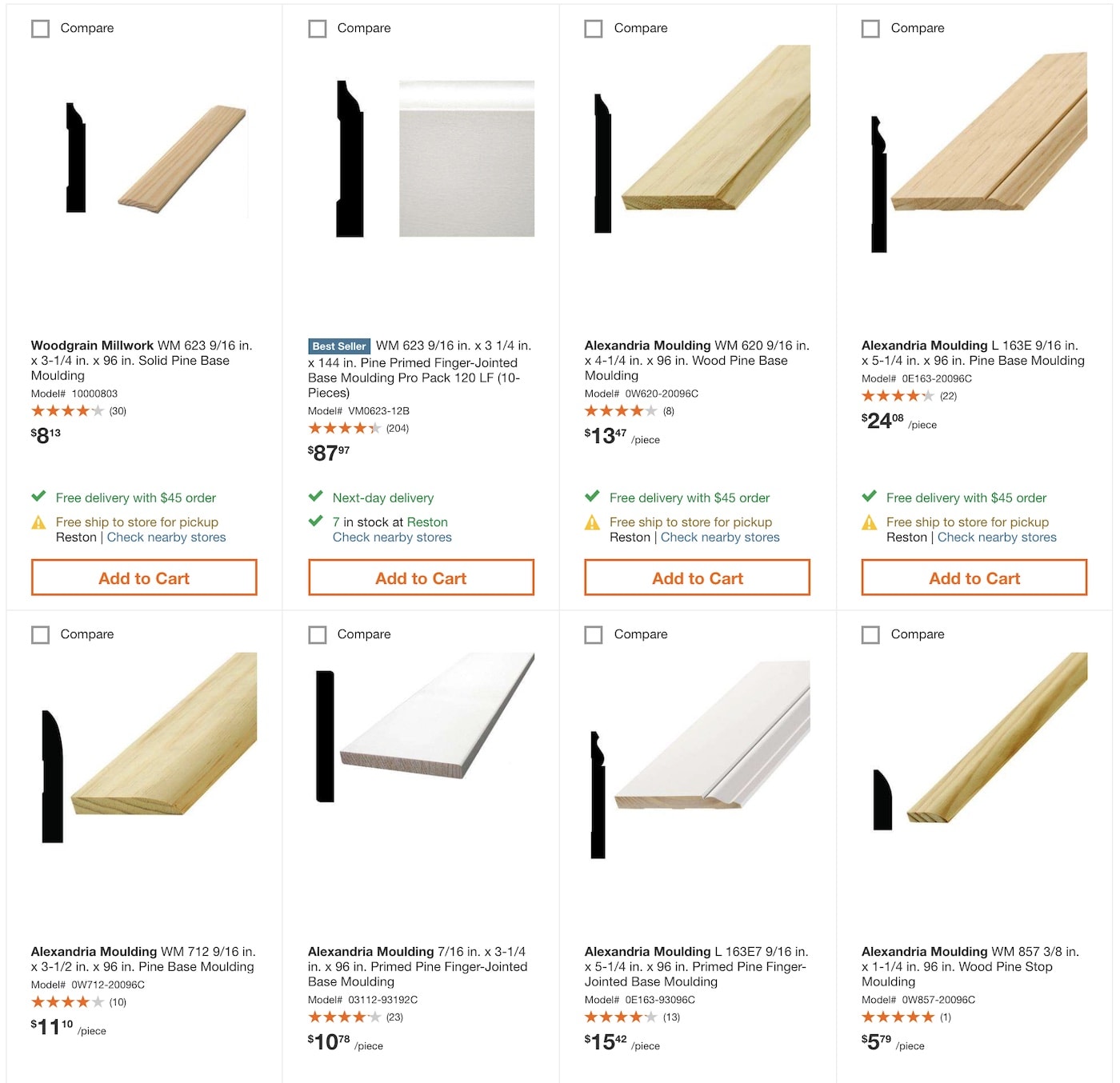Baseboards are an essential element in any home, providing both aesthetic appeal and functional protection for walls. Choosing the best nails for baseboard installation is crucial to ensure a secure and polished finish. With so many options available, it can be overwhelming to determine which nails will work best for your project. This guide will walk you through everything you need to know about selecting the right nails for baseboard installation, from material and size to tools and techniques. Whether you're a DIY enthusiast or a professional contractor, this article will equip you with the knowledge to achieve flawless results.
Baseboard installation is not just about aesthetics; it also involves protecting your walls from scuffs, dirt, and damage. Using the wrong nails can lead to unsightly gaps, loose boards, or even damage to your walls. To avoid these issues, it’s important to understand the different types of nails available and how they can impact your project. This article will delve into the specifics of nails for baseboard installation, ensuring that your project is both durable and visually appealing.
As we explore the best nails for baseboard installation, we’ll also discuss the importance of proper tools, techniques, and safety measures. By the end of this article, you’ll have a clear understanding of how to choose and use the right nails for your baseboard project, ensuring a professional finish that will stand the test of time.
Read also:Jenaveve Jolie Retired A Comprehensive Look At Her Career And Legacy
Table of Contents
- Types of Nails for Baseboard Installation
- Materials Used in Nails for Baseboard
- Best Nail Sizes for Baseboard
- Essential Tools for Installing Baseboard Nails
- Proper Techniques for Nailing Baseboards
- Safety Tips When Using Nails for Baseboard
- Common Mistakes to Avoid
- Maintaining Your Baseboard Installation
- Alternatives to Traditional Nails
- Conclusion
Types of Nails for Baseboard Installation
When it comes to baseboard installation, not all nails are created equal. The type of nail you choose can significantly impact the durability and appearance of your baseboard. Below are the most common types of nails used for baseboard installation:
- Finishing Nails: These are the go-to choice for baseboard installation due to their small heads, which can be easily concealed. They are ideal for achieving a clean, professional finish.
- Brad Nails: Slightly thinner than finishing nails, brad nails are perfect for lightweight baseboards. They reduce the risk of splitting the wood.
- Pin Nails: These are the thinnest option and are often used for delicate trim work. They are less likely to cause damage to the baseboard material.
- Casing Nails: Slightly larger than finishing nails, casing nails provide extra holding power for heavier baseboards.
Each type of nail has its own advantages and is suited to specific types of baseboard material and wall conditions. Understanding the differences will help you make an informed decision for your project.
Why Finishing Nails Are Preferred
Finishing nails are often the preferred choice for baseboard installation due to their ability to blend seamlessly with the baseboard. Their small heads can be countersunk and filled with putty, leaving no visible marks. This makes them ideal for achieving a polished, professional look.
Materials Used in Nails for Baseboard
The material of the nails is another critical factor to consider when selecting the best nails for baseboard installation. Different materials offer varying levels of durability, corrosion resistance, and aesthetic appeal. Below are the most common materials used in nails for baseboard:
- Steel Nails: Known for their strength and affordability, steel nails are a popular choice for baseboard installation. They are available in both galvanized and non-galvanized options.
- Stainless Steel Nails: These nails offer superior corrosion resistance, making them ideal for areas with high humidity or moisture, such as bathrooms or kitchens.
- Aluminum Nails: Lightweight and rust-resistant, aluminum nails are a good option for indoor baseboard installation. However, they are not as strong as steel or stainless steel.
- Copper Nails: Often used for decorative purposes, copper nails add a unique aesthetic to baseboard installations. They are also corrosion-resistant but come at a higher cost.
Choosing the right material depends on the specific needs of your project, such as the environment where the baseboard will be installed and the desired aesthetic.
Galvanized vs. Non-Galvanized Nails
Galvanized nails are coated with a layer of zinc to prevent rust and corrosion, making them ideal for areas with high moisture levels. Non-galvanized nails, on the other hand, are less expensive but may rust over time. For long-term durability, galvanized nails are the better choice.
Read also:Scandal Cases In The Philippines 2024 Unveiling The Truth
Best Nail Sizes for Baseboard
The size of the nails is another important consideration when installing baseboards. Using nails that are too short may result in a weak hold, while nails that are too long can damage the wall or baseboard. Below are the recommended nail sizes for baseboard installation:
- 2-inch Nails: These are the most commonly used nails for baseboard installation. They provide a secure hold without penetrating too deeply into the wall.
- 1.5-inch Nails: Ideal for lightweight baseboards or areas where wall thickness is a concern.
- 2.5-inch Nails: Best suited for heavier baseboards or areas that require extra holding power.
Choosing the right nail size ensures a secure and durable installation while minimizing the risk of damage to your walls and baseboards.
How to Measure Nail Length
To determine the appropriate nail length, measure the thickness of your baseboard and add at least 1 inch to ensure the nail penetrates the wall stud. This will provide a strong and secure hold.
Essential Tools for Installing Baseboard Nails
Having the right tools is essential for a successful baseboard installation. Below are the tools you’ll need to install nails for baseboard effectively:
- Hammer: A lightweight hammer is ideal for driving nails into baseboards without causing damage.
- Nail Gun: For faster and more precise installation, a pneumatic nail gun is highly recommended.
- Nail Set: This tool is used to countersink nails, ensuring a flush finish with the baseboard surface.
- Putty Knife: Used to apply wood filler over nail holes for a seamless finish.
Using the right tools not only makes the installation process easier but also ensures a professional-looking result.
Benefits of Using a Nail Gun
A nail gun allows for quick and precise nail placement, reducing the risk of splitting the baseboard or damaging the wall. It’s especially useful for large projects or areas with tight spaces.
Proper Techniques for Nailing Baseboards
Using the correct technique is just as important as choosing the right nails and tools. Below are some tips for nailing baseboards effectively:
- Always pre-drill holes to prevent the baseboard from splitting, especially when using hardwood materials.
- Drive nails at a slight angle to ensure a secure hold.
- Countersink nails using a nail set to create a flush surface.
- Apply wood filler over nail holes and sand smooth for a seamless finish.
Following these techniques will help you achieve a professional and durable baseboard installation.
How to Avoid Splitting the Baseboard
To avoid splitting the baseboard, use nails with a fine gauge and pre-drill holes before nailing. This is especially important when working with hardwood or delicate materials.
Safety Tips When Using Nails for Baseboard
Safety should always be a priority when working with nails and tools. Below are some safety tips to keep in mind during baseboard installation:
- Wear safety goggles to protect your eyes from flying debris.
- Use gloves to protect your hands from sharp nails and tools.
- Ensure your workspace is well-lit and free of obstructions.
- Keep tools and materials organized to prevent accidents.
By following these safety tips, you can complete your baseboard installation safely and efficiently.
Importance of Proper Lighting
Proper lighting is essential for accurate nail placement and to avoid mistakes that could compromise the quality of your installation.
Common Mistakes to Avoid
Even experienced DIY enthusiasts can make mistakes when installing baseboards. Below are some common mistakes to avoid:
- Using nails that are too long, which can damage the wall or baseboard.
- Failing to pre-drill holes, leading to split baseboards.
- Not countersinking nails, resulting in an uneven finish.
- Skipping the use of wood filler, leaving visible nail holes.
Avoiding these mistakes will help you achieve a professional and polished baseboard installation.
How to Fix Mistakes
If you make a mistake, such as splitting the baseboard, you can use wood glue and clamps to repair the damage. For visible nail holes, simply apply wood filler and sand smooth.
Maintaining Your Baseboard Installation
Proper maintenance is key to ensuring the longevity of your baseboard installation. Below are some tips for maintaining your baseboards:
- Regularly clean baseboards to remove dust and dirt buildup.
- Inspect for loose nails and tighten them as needed.
- Touch up paint or finish to keep baseboards looking fresh.
- Address any signs of water damage immediately to prevent further issues.
By following these maintenance tips, you can extend the life of your baseboards and keep them looking their best.
How to Clean Baseboards
Use a damp cloth to wipe down baseboards and remove dust. For stubborn stains, use a mild cleaning solution and a soft brush.
Alternatives to Traditional Nails
While nails are the most common choice for baseboard installation, there are alternatives worth considering:
- Adhesive Strips: These provide a nail-free option for lightweight baseboards.
- Screws: Offer greater holding power but may require more effort to conceal.
- Construction Adhesive: Provides a strong bond but is not suitable for all baseboard materials.
Each alternative has its own advantages and limitations, so choose based on your specific project needs.
When to Use Adhesive Strips
Adhesive strips are ideal for temporary installations or areas where drilling is not an option. However, they may not provide the same level of durability as nails.
Conclusion
Selecting the best nails for baseboard installation is a critical step in achieving a professional and durable finish. By understanding the types of nails, materials, sizes, and tools available, you can make informed decisions that will enhance the quality of your project. Remember to follow proper techniques and safety measures to ensure a successful installation.
We hope this guide has provided you with valuable insights into choosing and using the best nails for baseboard installation. If you found this article helpful, feel free to leave a comment or share it with others who may benefit. For more tips and guides on home improvement, explore our other articles and take your DIY skills to the next level!

